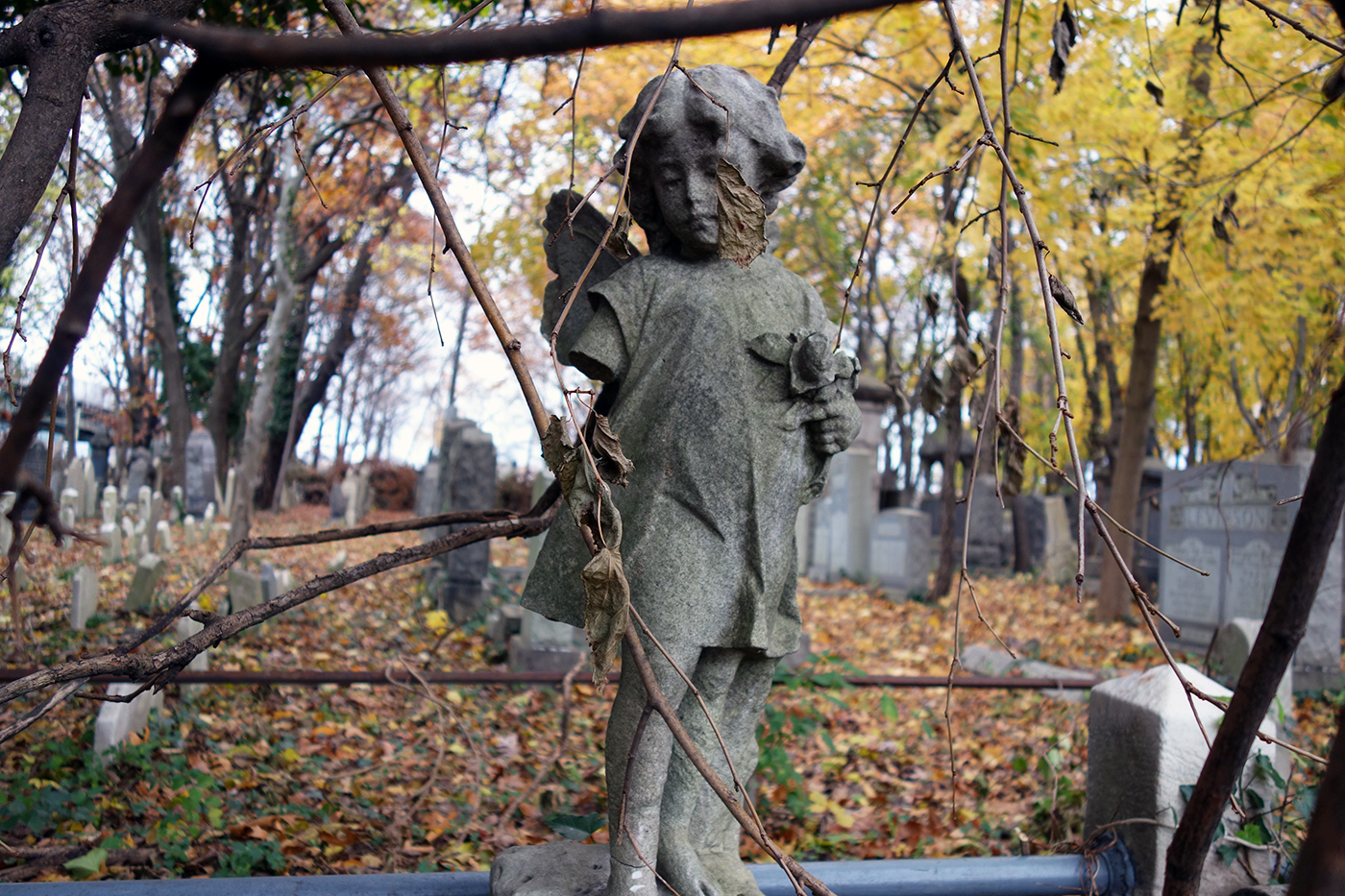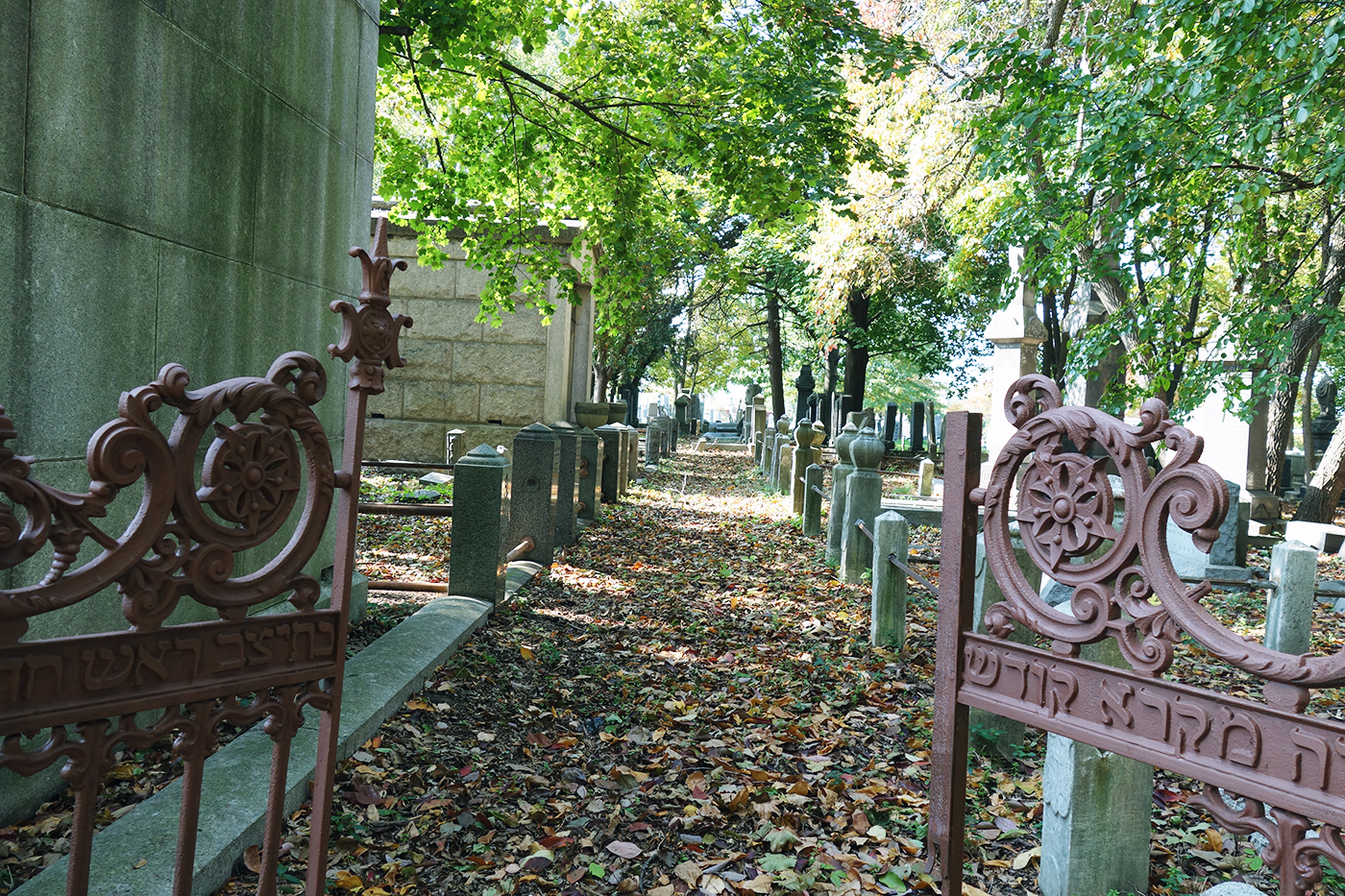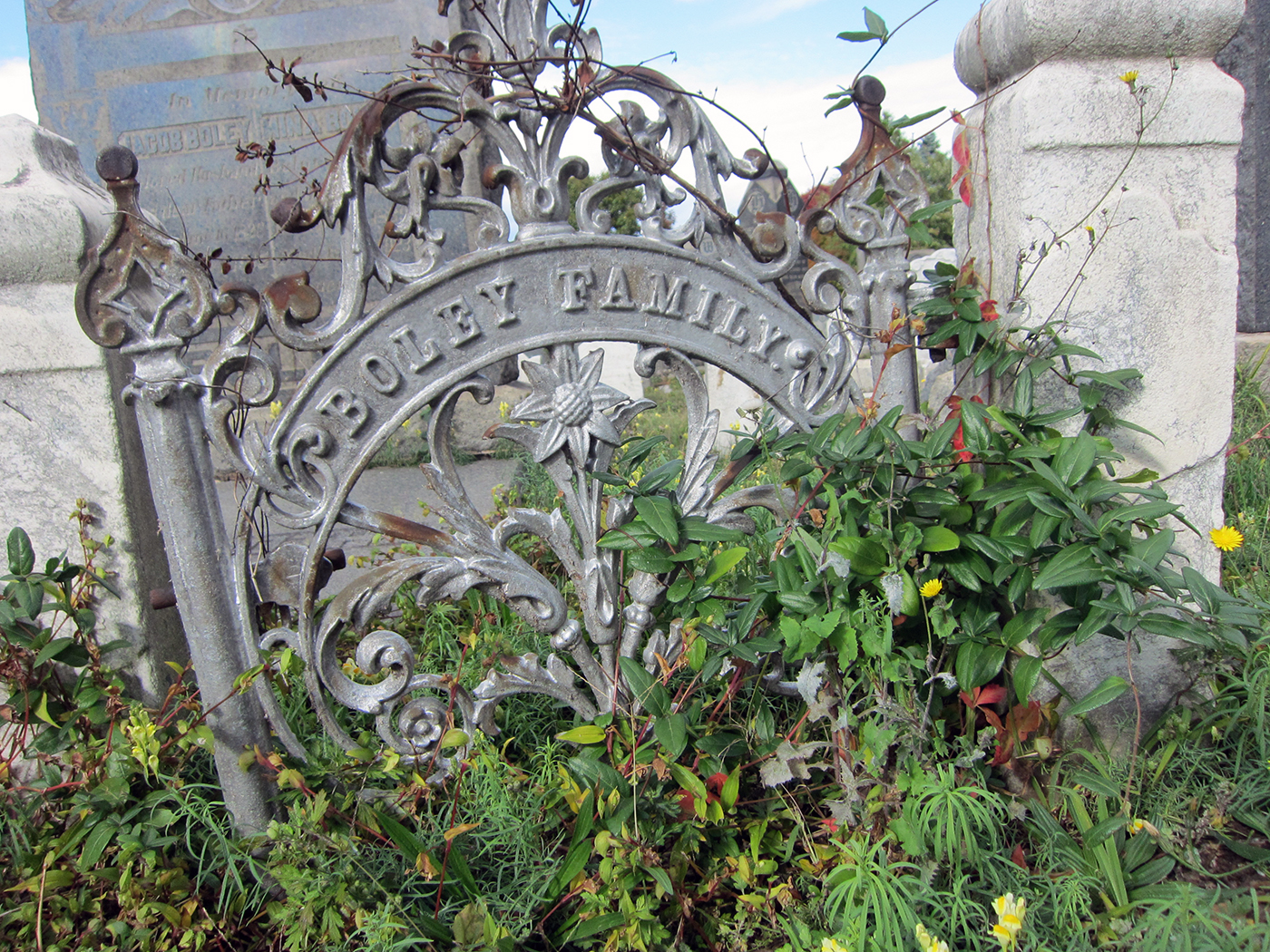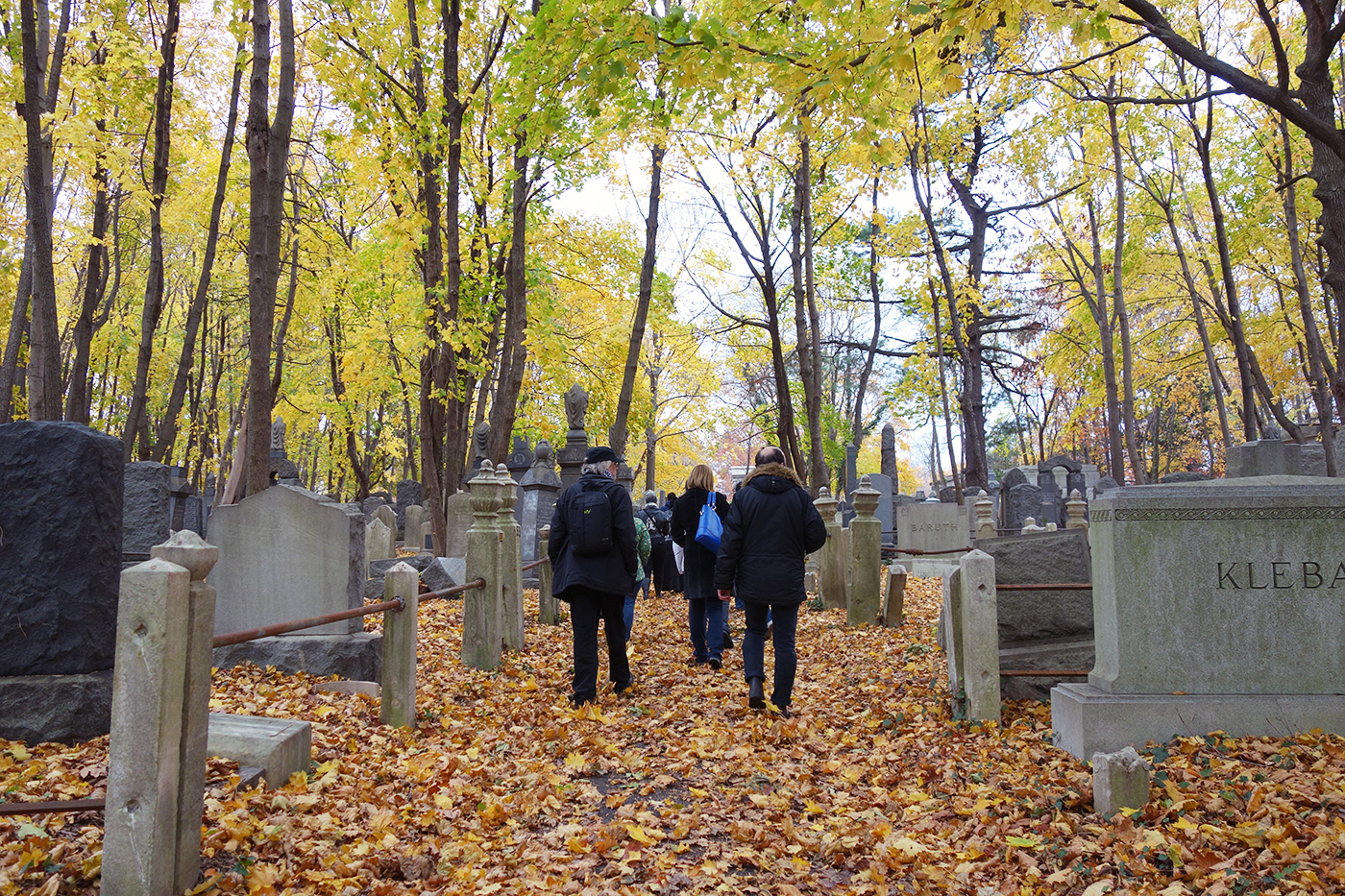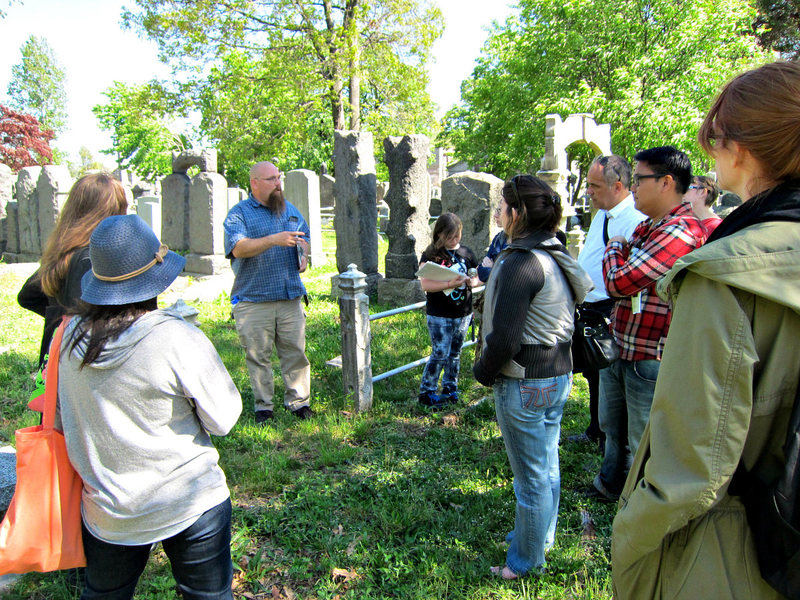Shrouded by trees and overgrown foliage, Bayside Cemetery is barely visible from the fence that surrounds this small Jewish burial ground in Ozone Park, Queens. New Yorkers can glimpse its granite tombs and mausoleums from the A train as it rumbles past on the elevated tracks, yet few visitors walk its weedy paths. While that seclusion and reclamation by nature can make it feel like a peaceful urban escape, those same elements have led to major vandalism and desecration over recent decades. Tombs have been toppled, coffins shattered and skeletons exposed, with one mausoleum even set on fire.
I first visited Bayside Cemetery in 2012, and was struck by the beautiful metal fences and old ceramic photographs on the headstones, and also the mausoleum doors replaced with rotting plywood, and the large number of tombstones that had been knocked over. It felt like a place New York City had forgotten. But I soon found there was a very dedicated person giving his weekends to its care. I connected with Anthony Pisciotta after I shared my photographs on Flickr, and we subsequently collaborated on a series of tours he led for Atlas Obscura between 2012 and 2016, when I was then the senior editor for the travel site. Those who joined (including for a tour held just days following Hurricane Sandy), always caught Pisciotta’s contagious enthusiasm for the place, where he seemed to know a story behind every grave.
“I like history and I like working with my hands, so it’s a great thing for me, because I can do both,” said Anthony Pisciotta, whose day job is with the Metropolitan Transportation Authority (MTA)’s Bridges and Tunnels. Established in the 1860s, Bayside has around 35,000 burials, representing the vibrant diversity of over a century of New York City Jewish life, from religious leaders to Civil War veterans to an Ostrich feather seller who died on the Titanic. The Victorian-style monuments are decorated with as many urns and angels as Stars of David and Cohen hands, and stained glass and mosaic floors adorn many tombs. It sits on a stretch of land with three cemeteries, bordered by Acacia on its east and Mokom Sholom on the west; you know you’ve reached Bayside when you’re walking in the shadows cast by the spindly trees that have been left to grow wild.
Pisciotta first noticed Bayside in the early 1990s when he drove a delivery truck for a food distributor, and often passed by on the adjacent Pitkin Avenue. “It was really overgrown back then, and it caught my eye, that a cemetery could be that overgrown and that run down,” he said. In 2003, he caught a news report about a group of Mormons who were volunteering to clean the place, so he went out to help. Then in 2011, when he was working his new job for Bridges and Tunnels, he again passed by, and remarked that it had improved. He had a long weekend for the July 4th holiday, and decided to return with his son and some gardening tools.
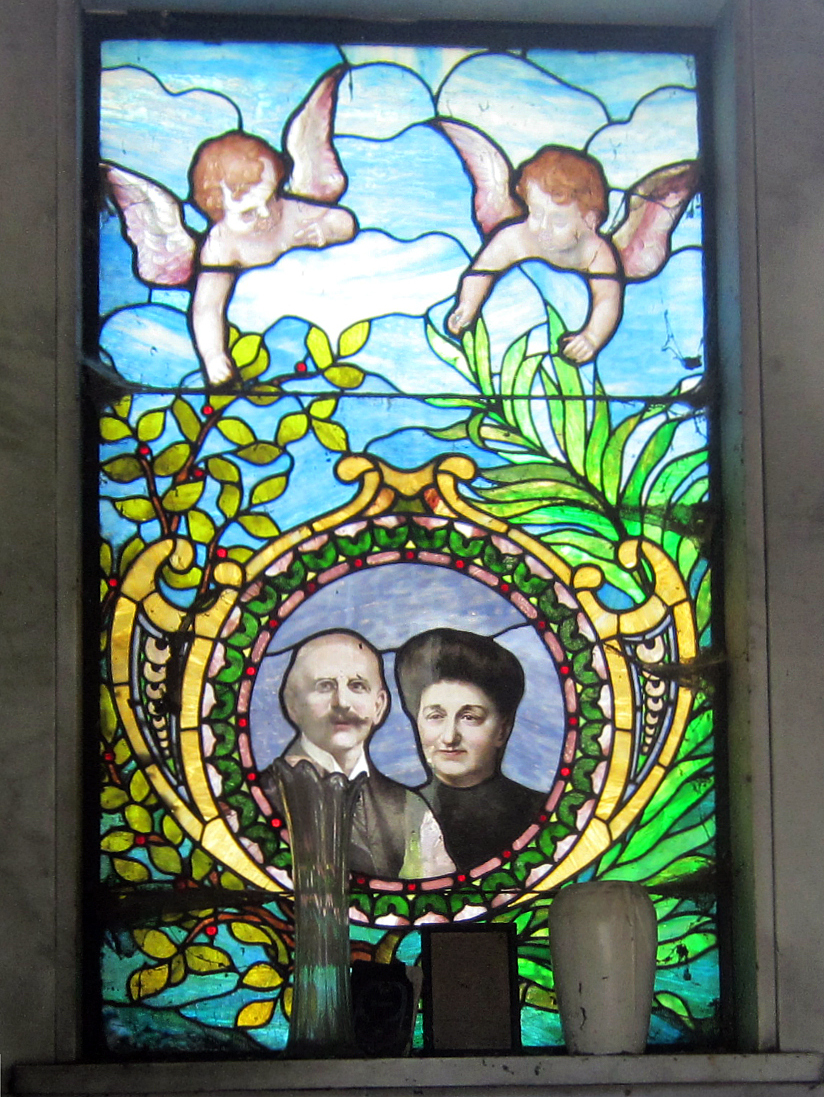 “I picked this one plot that was way in the back because there were some children there who had died really young,” he said. “So we started cleaning it, and my son wandered off, maybe a couple of hundred feet away from us, where there was a mausoleum. He comes back to me and he says, ‘Dad, you’re not going to believe this but it’s open, this mausoleum.’ And you could see inside of it, and you could see the skeletons and everything.”
“I picked this one plot that was way in the back because there were some children there who had died really young,” he said. “So we started cleaning it, and my son wandered off, maybe a couple of hundred feet away from us, where there was a mausoleum. He comes back to me and he says, ‘Dad, you’re not going to believe this but it’s open, this mausoleum.’ And you could see inside of it, and you could see the skeletons and everything.”
The broken coffins, and the exposed bones, seemed like they had been that way for a while. “I was pretty upset about what I’d seen, because I didn’t think that that should be like that,” he said. “And I started making some phone calls to the city, to anybody I thought might be able to help.”
Since the cemetery is managed by a synagogue and not the state, he found that getting someone to pay attention was difficult. “I really didn’t want to call the media because I felt they would turn it into like a big creepy, scary story, but I felt that the ends justified the means,” he explained. “I got interviewed by two different news crews, and after that I said to my wife, ‘I could be one of the people who complains, or I could be somebody that’s going to actually do something to try to change the situation.’ So I started going out there doing work, cleaning up different plots. And it progressed until I started to repair stones that had been pushed over.”
So although he is not Jewish, and has no relatives at Bayside, he began devoting his free time to the cemetery’s improvement. He built a piece of equipment designed to lift and reset stones, soldered broken iron gates, carefully reconstructed an angel that marked a child’s grave, and connected with other people who wanted to restore dignity to this place. A man whose father was buried there gave some funding to seal the open mausoleums to discourage further damage and theft. And Pisciotta used his passion for research and history to delve into the identities of the interred, scouring old New York Times newspapers, the New York Public Library, the Municipal Archives, and sharing information with organizations like the Shapell Roster, a digital archive of Jewish people who fought in the Civil War. All these fragments of information filled in gaps in the sparse synagogue records. It also led to previously unmarked veterans’ graves receiving their honors, such as Irving Aron, a marine killed in Nicaragua in 1930 whose monument was blank after his metal marker was stolen.
Despite Pisciotta’s work and that of other volunteers and groups like the Community Association for Jewish At-Risk Cemeteries (CAJAC), Bayside is again in a decline. “The congregation cut off the cleaning of the cemetery since last April, so it’s back to where it was,” he said. Due to the return of the overgrowth, and the continuous dumping of trash on the grounds, it’s currently too dangerous to do restoration. However, he still attends to graves that he knows are regularly visited by families, so they can safely visit and see their loved ones’ names. He hopes that a change in management may lead to better care of the cemetery, but for now it’s a matter of what he calls “triage” — making small efforts to make it as welcoming as possible for those who come to remember and mourn. “I’m not going to give up on the place, and I’m going to continue to try to get people interested in it, and try to shake the tree,” he said.
Bayside is not unique, as around the world there are cemeteries that, for a variety of reasons, have been left to deteriorate. Pisciotta noted that anyone who takes an interest in their local burial grounds can contribute to their care.“Not everybody has to work with their hands, either,” he stated. “There are a lot of cemeteries that need help with getting their data online so that researchers can find it. You can get involved in going out and photographing the cemeteries so they can be uploaded online where people can see it.” As he affirmed, “There’s always room for people to help.”
All photographs by the author.

